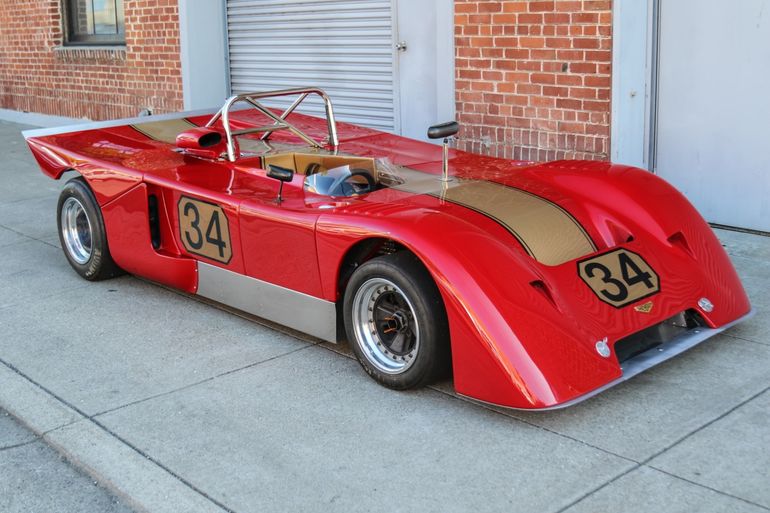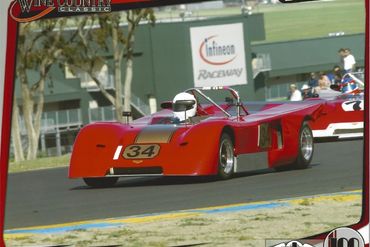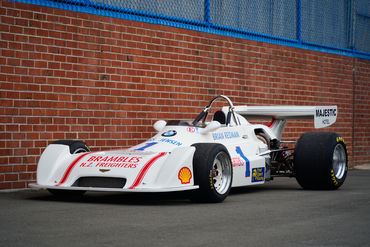Sold
SOLD 01/20
1971 Chevron
B19
Known Ownership and Early European Race History. Frequent Monterey Historic Reunion Participant. Comprehensively Restored and Rebuilt, with Zero Time Since Completion. Cosworth Engine by Dave Vegher
- VIN71/28
- Exterior ColorRed with Gold Racing Stripe
- Interior ColorBare Aluminum
- MileageTMU
- Engine2.0 Liter Inline 4-Cylinder DOHC Cosworth BDG
- Transmission5-Speed FT 200 no. 1197
- StatusSold
- StockFJ2375
Description
1971 Chevron B19
Arch Motors # B19 71-28
Red with Gold Racing Stripe
Considering the vast resources and technical sophistication it takes to develop a racecar, Chevron must be counted as one of the most innovative and successful independent racecar companies ever assembled. Despite their bootstrap beginnings and minimal finances, self-taught engineering genius and founder Derek Bennett managed to build a profitable business making fantastic racecars. Unlike many experts in the complex and often burgeoning world of motorsports racing, Bennett’s lack of specialized engineering training, college degree, or marketing savvy ultimately became his ace against competitors. His fascination with aircraft, short-lived apprenticeships in a range of fabrication shops, and deftly cobbled experiments, made him scrappy and effective at quickly solving practical problems.
Under these conditions, Bennett built a cadre of like-minded craftsmen and clever engineers, quickly establishing Chevron as a top competitor, amassing race wins in every category entered, right up to Formula One, where a promising car was planned but never completed. Chevron’s best and most successful cars were 2.0L Sports Racers. Along with Lola, Chevron cars were among the most competitive small-bore sports racings cars of the 1970s, leveraging their lightweight and durable chassis construction with proven engines and astutely designed aerodynamic bodies. Both Chevron and Lola essentially dominated sprint and endurance 2.0L sports car racing, with Chevron winning their class at the famed 24 hours of Le Mans three times: 1974 (B23), 1979, and 1980 (B36). Having learned a great deal from the construction of the B16 series cars, the B19 became the successor to the B16 Spyder. Armed with the learning from the B16 Spyder, the B19 not only established a refined direction for their chassis designs, it literally became the seminal architecture for the B21, B23, B26, and B31 series of open cars. Using mostly aluminum construction now in place of the former heavier steel and duraluminum from the B16, the B19 was lighter and, with the preferred Cosworth FVC engine, an immediately competitive car. Light and quick, with exceptional handling characteristics, the B19 proved itself to the world in their inaugural year winning the 1971 European two-liter Sports Car Championship, with Brian Redman at the wheel.
This particular B19 has been documented from new in copious expert detail particularly in the early years of competition. The car was built in the summer of 1970 and purchased by veteran hill-climb specialist Reg Phillips of Tewkesbury, England. Phillips campaigned the car through 1971, 1972, and 1973 in British hill-climb events. After a remarkable twelve class wins and many 2ndand 3rdplace finishes, on September 30, 1972 Phillips won his class and set the first of four new records at Weston BP/RAC Sprint. After racing the car for three seasons, in 1973 Phillips sold the car to Chippy Stross who installed an FTC engine and competed in 1974 and 1975 British hill-climbs. By the late 70s, B19 71-28 is known to have been in New Mexico and later represented by Brian Redman when the car is sold in 1985 to Earl Dunn, Ontario, Canada who raced it in the 1985 SVRA season (Moroso, Sebring, Watkins Glen, and Atlanta). At the end of 1985, the car was restored and shown at the 1986 Bahamas event where it won the “Peoples’ Choice Award”. From 1986 to 2006, the car continued to race primarily on the east coast and with Redman’s “Targa Group 66” events.
In 2007, the current owner acquired the car and engaged Intrepid Motor Cars, Sparks, Nevada to comprehensively refurbish the mechanicals and, by 2009, installed new bodywork (purchased from Chevron Racing). The body was painted and fit to the chassis and a BDG engine, rebuilt by David Vegher, Veloce Motors West, was installed. During this work, the oil cooler was relocated to the left side, an air intake, and brake-cooling ducts were added. Additional work at this time included replacing all hoses, electrical wiring, and updating hardware as needed. The car completed throughout the West Coast in HMSA, General Racing, and CSRG until August 2016 when it was damaged at Laguna Seca Raceway during the Monterey Pre-Historics. In an effort to determine the best course for repairs, the car was disassembled, evaluated and the decision was made to engage Chevron Racing to fabricate a correct specification tub to replace the damaged original. The undamaged components from the car were removed and installed on the new tub. The unique and original components from the former tub that could not be used in the restoration are included as spares along with the original tub, which retains the correct factory number located on the suspension upright.
Known for their expertise and quality craftsmanship, Intrepid Motorcar Company was engaged again, this time to completely restore the car. The project took over two years from late 2016 through 2018 to complete. Invoices accompanying the car total over $178,000.00 attesting to the superb craftsmanship and mechanical refinement befitting a car of this status. Every part was sourced from top suppliers including Chevron Racing. A brief list of components replaced or rebuilt included suspension components, Chevron uprights, Chevron carrier housing, new rotors, rebuilt shocks, polished headers, twin custom fabricated fuel cells, and of course the newly constructed Chevron chassis which included an extra knee support, front bottom wishbone, and rear wishbone, balance pipe and clips, extra fuel tank hatchnut rings, a set of water rails, oil tank, front camber link, and engine mounts. Numerous nickel-plated parts were also used including the polished shift lever, caster links, brackets, and other suspension components. The David Vegher built engine was dyno tested showing 289.6 peak horsepower. The engine has run just seven hours and remains very strong During the final assembly, new electrical wiring was reinstalled, and all systems checked for good operation The fiberglass bodywork was prepped, painted, striped and numbered, and then installed for final fitting. The completed car has since been run only briefly for testing and sorting.
Having been so carefully documented, this B19 is just one of only 34 built and today presents to sparkling high-quality standards, with all surfaces virtually unmarked and final assembly competitive to any top-tier 2-liter restored racecars. The paint is in excellent condition overall with high gloss red and a clean gold central stripe. The cosmetic condition of the bodywork, paint and numbering is of very high quality. The pure and simple paint scheme allows for the aerodynamic bodywork to show exactly why these cars were considered one of the most dynamic designs of the decade. The lightweight bodywork sits low and tight on the chassis, with only the offset air scoop and chrome roll bar peeking out from the dramatically low-profile body lines. Functional louvers, intake and exhaust vents, and blade edged aerodynamic foil, finish off the sophisticated bodywork. These innovative features, remarkable for 1970 development are integral parts of the performance and stability of these exceptional racecars.
Inside, the cockpit is clean, simple, and properly sorted. A modern racing seat, up to date restraint system, and a proper fire system present nicely against the raw aluminum finishes. The car sits on correctly sized wheels shod with Avon racing tires. The cockpit features a properly anchored roll bar and lightweight externally mounted carbon fiber dual position rear view mirrors.
Under the lightweight body sections, the Chevron Racing built frame and has been fitted with correct components and restored with attention to detail using high quality materials, updated fasteners, and durable finishes where needed. The engine is in beautiful condition with a run time of just seven hours, while the engine compartment has been beautifully prepared with added care unifying both cosmetic presentation and mechanical integrity. The fuel delivery system, electrical, and suspension components also reflect the quality of the build throughout. The chassis and suspension components all present with the same level of integrity and finish. The resultant finished car has not only been completed using a new tub fabricated by Chevron Racing (the original manufacturer), all suspension corners are basically new, allowing the next owner tremendous piece-of-mind knowing that formerly fatigued metal has been remediated in this build.
The car is accompanied by a very carefully prepared history of this chassis, early racing results and ownership, and details of the more recent racing history. Included with these records are extensive receipts for parts and service performed recently on the car. Additionally, a significant number of mechanical spares, suspension components, body sections, the original tub, and various wheels are also included with the sale. The list of spares is itemized below.
· Windscreen, NEW
· Cylinder Head (used)
· 2x brake pad sets NEW
· 2x brake rotors (used)
· 4x wheel bearings NEW
· Input shaft, u-joint NEW
· 2x A-arm hangers, bushings NEW
· Suspension upgrights, spindles, NEW
· 3x NEW or used starters, driveline donut, NEW
· Cam cover gaskets, fuel pump, fuel filter, all NEW
· 4x shocks and wheel nuts and springs (used)
· Fuel regulator and extra timing belt
· 4x A-arms and related suspension links (used)
· Transaxle internals (used), oil filter perch, fuel regulator
· Brake calipers (used), MC, and res Engine connecting rods (used)
· Harmonic balancer, brake duct, exhaust hangers, water swirl pot (used)
· Exhaust hangar, ducts, various other minor spares
· Extra plug wires, coil, shift forks, throttle cable
· Shift rods, body support rods, and trailing links (used)
· Body support rods, water system swirl pot (used)
· OLD fuel cell bladders
· Radiator (used)
· Fuel cell bladders (used)
· Oil tank, (used – dented)
· Partial wheel set, damaged
· Original mag wheels, for display
· Partial wheel set (used – damaged)
· Org tub with AM 71-19 marking
· Windshields for patterns
· Event stickers
· Extra body
Among the most exciting and important 2.0 liter racecars, this highly documented Chevron B19 has been carefully rebuilt and restored using the original builder, Chevron Racing, highly skilled contemporary 2-Liter racing experts, and is today exceptionally well-prepared for the next fortunate and dedicated racing enthusiast to enjoy and campaign with pride.
The above vehicle information is complete and accurate to the best of our knowledge at the time it is posted to this website. Corrections or additional information is always appreciated. All advertised prices exclude government fees and taxes, any finance charges, any dealer document preparation charge, and any emission testing charge. Vehicles are subject to prior sale. All advertised to be true but not guaranteed. We assume no liability for errors or omissions.
Inquire About This Car
Fantasy Junction • 510-653-7555 • 1145 Park Ave, Emeryville, CA 94608



